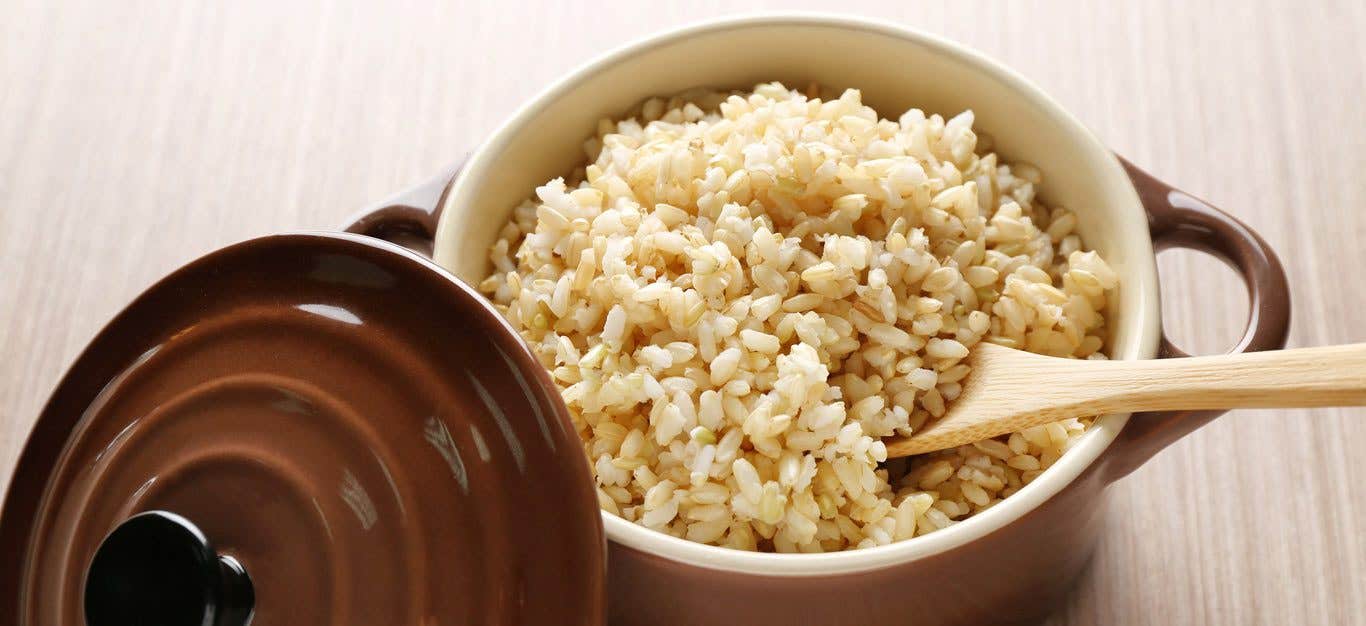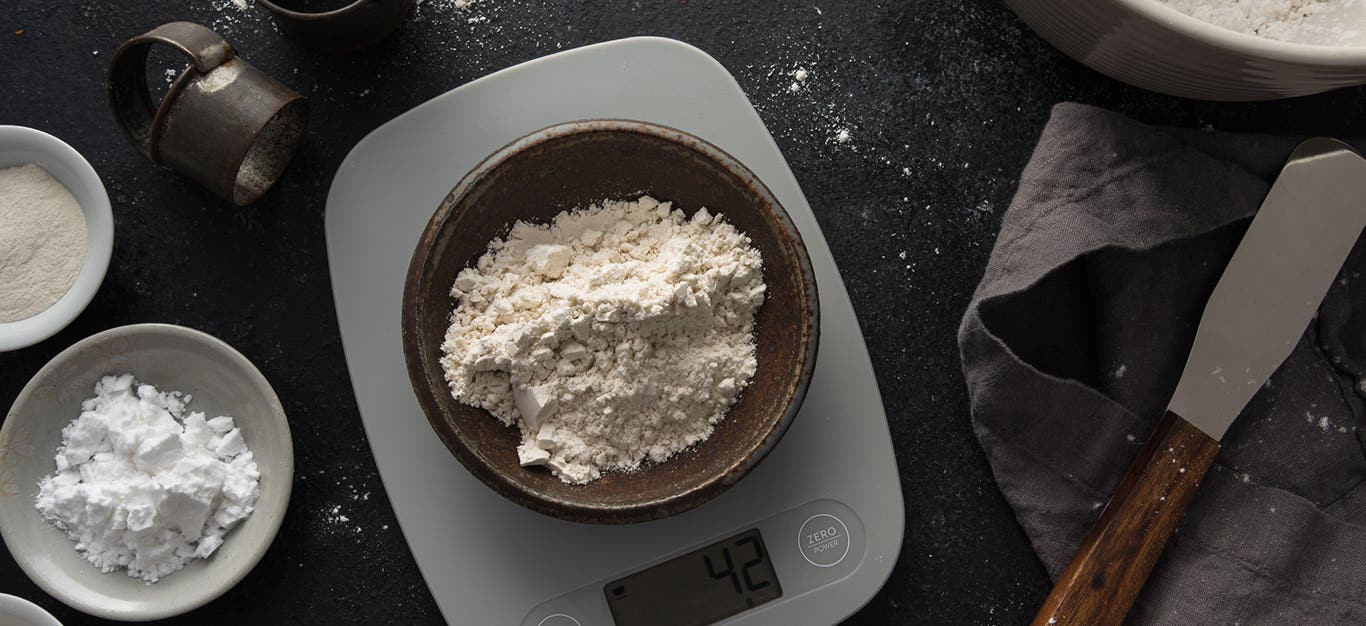The key to taking a good rice dish and turning it into a great one? Choosing the right rice for the recipe. This handy guide covers all the brown and other whole grain rice options available, plus substitution options for each. Read on so you can shop smart and make your rice recipes really sing.
Brown Rice Is Not the Only Whole Grain Rice
Brown rice gets its color and its name from the brown bran coating that is left on the grains after (minimal) processing. It has become synonymous with whole grain rice, but not all whole grain rice is brown. Black, purple, and red rice are also unrefined rice varieties with bran layers that have been left intact.
Rice Grain Size
Rice comes in three grain sizes: short-grain, medium-grain, and long-grain. Short-grain rice is small, starchy, and even sticky (think: sushi rice). Long-grain rice varieties, like basmati, have a lower starch content and cook up light and fluffy. Medium-grain rice falls in-between short-grain and long-grain. It is less fluffy than long grain, less starchy than short grain, with a firm, slightly chewy texture.
Types of Whole Grain Rice
Now that you know about bran content and rice sizes, here are the different types of whole grain rice to choose from.
Brown Basmati Rice (Long Grain)
Basmati rice has long, thin grains that cook up dry, soft, and fluffy. It is native to the Indian subcontinent and remains the most popular rice in India. Brown basmati rice is also the obvious choice for Indian recipes, such as biryani. It also works well for soups, casseroles, and rice pilaf—anywhere you want rice to hold its shape and texture.
Best substitutes: Any other long-grain brown or whole grain rice
Brown Texmati Rice (Long Grain)
Texmati rice is a basmati hybrid grown in America that is tender and light with a toasty popcorn flavor. As the name implies, Texmati rice’s texture is similar to basmati, and it can be used interchangeably in any recipe that calls for basmati or long-grain brown rice.
Best substitutes: basmati rice, Carolina Gold rice (another American hybrid), or any other long-grain brown rice
Brown Jasmine Rice (Long Grain)
Super aromatic jasmine rice cooks up light and slightly firm. It’s the most popular rice in Thailand, where “new crop” jasmine rice is prized for its distinctive fragrance and taste. We specifically call for jasmine rice in our Oil-Free Tofu Fried Rice, but you shouldn’t reserve it solely for Asian dishes: Jasmine rice’s moist, tender texture makes it an excellent all-purpose rice option.
Best substitutes: any long- or medium-grain brown rice
Black ‘Forbidden’ Rice (Short, Medium, and Long Grain)
Black rice is an heirloom variety from China that contains anthocyanins, the same natural pigments that give eggplants their stunning black or purplish color. The grains have an earthy, robust, whole grain flavor that’s stronger than most other rice varieties. Try black rice in grain bowls, rice salads, and sushi rolls to add a splash of dramatic color.
Best substitutes: medium-grain brown rice or red rice
Red Rice (Short, Medium, and Long Grain)
Red rice is native to different regions around the world and can be short-, medium-, or long-grain, depending on where it is grown. Its ruddy-hued bran coating keeps the grains firm and distinct and gives them a nutty, slightly sweet flavor that is similar to wild rice. Try blending red rice with brown rice to add texture, or use it on its own in grain bowls, salads, pilafs, and soups.
Best substitutes: wild rice, Calrose brown rice, and black “forbidden” rice
Brown Sushi Rice (Short Grain)
High-starch sushi rice is extremely mild-flavored, soft and sticky. It is sometimes called Japanese rice and can be easily shaped for sushi. Use it to make sushi and in any recipe that calls for short-grain rice, including rice pudding and risotto.
Best substitutes: short-grain brown rice, black “forbidden” rice, and Calrose brown rice
Brown Arborio or Carnaroli Rice (Short Grain)
Arborio and Carnaroli are Italian rice varieties that are used for risotto. Their starchy, creamy texture when cooked also make them good for breakfast porridges and rice puddings.
Best substitutes: short-grain brown rice, brown sushi rice, and Calrose brown rice
Calrose Brown Rice (Medium Grain)
This ultimate all-purpose rice bridges the gap between fluffy long-grain and sticky short-grain varieties to be firm but creamy. Its mild flavor and creaminess make it a delicious option for risotto when brown arborio rice is unavailable.
Best substitutes: red rice, sprouted rice, sushi rice
Carolina Gold Rice (Long Grain)
This heirloom variety from South Carolina was reintroduced on the rice market by Anson Mills in 1998. It has an earthy fragrance and flavor that is highly sought after by chefs. If you can find it, try Carolina Gold rice in any recipe that calls for basmati or long-grain brown rice.
Best substitutes: brown basmati, Texmati rice
Black Sticky Rice (Long Grain)
Also called glutinous or sweet rice, sticky rice is a cultivar that is high in amylopectin, a plant starch that makes the grains stick together when cooked. Whole grain sticky rice is black or purple. Sticky rice is usually soaked and steamed before it’s added to sweet and savory recipes, but it can also be used to make risotto or rice pudding.
Best substitutes: short grain brown rice, sushi rice
Sprouted Brown Rice (Long or Short Grain)
Sprouted rice isn’t a specific rice varietal. Any type of brown rice can be allowed to germinate before it is dried to become sprouted rice. It has to be brown rice, though, as refined white rice won’t germinate. The sprouting process gives it a robust, hearty flavor while increasing the bioavailability of the grains’ nutrients. Use sprouted rice in recipes where rice texture and flavor are important.
Best substitutes: red rice, black “forbidden” rice, and Calrose brown rice
Whole Grain Rice Recipes
Enjoy the earthy goodness of whole grain rice in these healthy plant-based recipes from Forks Over Knives.
- Easy Purple Sticky Rice Pudding
- Sicilian Rice Balls with Mushrooms and Peas
- Layered Black Rice Salad
- Forbidden Rice Bowl with Quick-Pickled Cabbage
- Individual Broccoli and Wild Rice Casseroles
- Pomegranate Wild Rice Salad
- Stirred-not-Fried Wild Rice
- Wild Rice, Chickpea, and Cabbage Pilaf
- Ethiopian Wild Rice Pilaf
- Herbed Instant Pot Rice Pilaf
- Teriyaki Jackfruit and Rice Stacks
- Indian Brown Rice Pudding (Kheer)
- Brown Rice Breakfast Pudding
- Easy Vegan Sushi Recipes

Related News
Get Our Best Price On The Forks Meal Planner

Forks Meal Planner takes the guess work out of making nutritious meals the whole family will enjoy.
SAVE $200 ON OUR ULTIMATE COURSE

Join our best-selling course at a new lower price!



